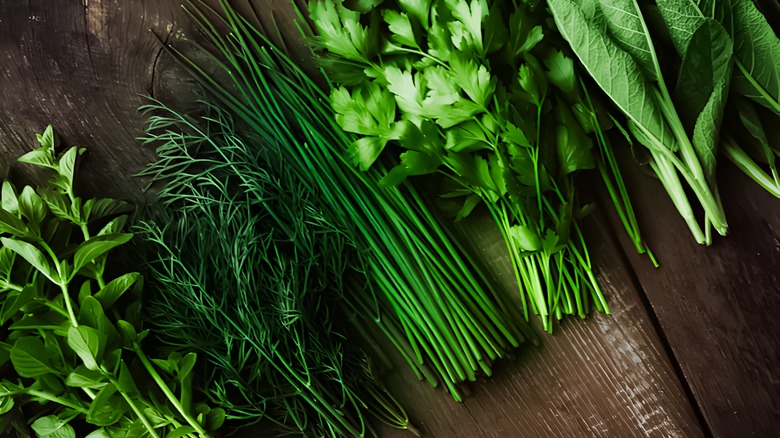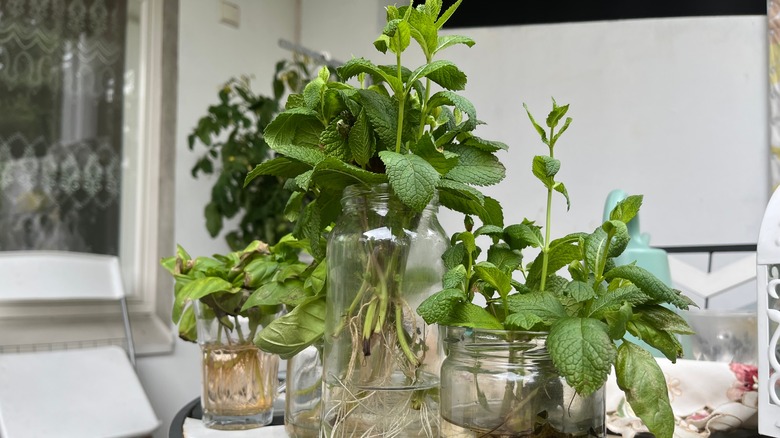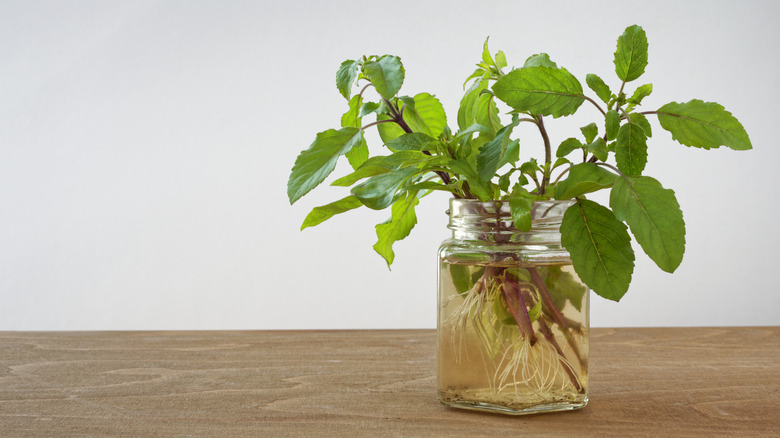Herbs You Can Grow In Your Kitchen Without Any Soil
We may receive a commission on purchases made from links.
Beyond cooking, fresh-picked herbs have tons of helpful uses, like making teas and using common herbs from your garden to keep your home clean. If you've got no soil, no problem — growing herbs in water is one of the most beginner-friendly, cost-effective ways to get started. You can easily grow popular herbs like mint, basil, and chives without soil, and all you need to get started is a pair of scissors and a container of water.
Growing plants indoors without using any soil is called hydroponic gardening. Herbs happen to be one of the plant types that easily adapt to this style of growth. In fact, with the proper care, they can even grow faster than their soil-grown counterparts thanks to the easy access to moisture and nutrients. You can keep herbs in your kitchen all year long this way.
This method also requires less water, space, and maintenance than gardening in soil. That said, it's still important to account for the unique needs of plants growing in indoor hydroponic gardens to keep your herbs happy and healthy. Here's which herbs grow best in water and how to keep them healthy in your kitchen.
How to start growing herbs in water
While many herbs can root in water, some are easier to grow this way than others. Herbs with soft stems such as mint, oregano, basil, and lemon balm are all strong contenders, as well as chives. Hard-stemmed herbs like rosemary, thyme, tarragon, or sage can also grow in water, but take longer to root and may not grow to large enough sizes in water to harvest much. Also, cilantro, dill, and parsley are trickier, and tend to grow best from seed.
Start by taking cuttings from a mature plant or store-bought herb packets. First sanitize your scissors by washing with soapy water or wiping with rubbing alcohol. Then cut a 3- to 4-inch segment just below a leaf node (where the leaf meets the stem). If you're working with a hard-stemmed herb, use the newer green growth. If you're working with grocery store herbs, you can just make a new, clean cut at the bottom of the sprig.
Then remove the lower leaves and trim the plant so that just two to three leaves remain at the top. Clip any flowers or buds as well to help encourage the plant to direct its energy to rooting. Place each cutting in a clean jar with room-temperature, non-chlorinated water. You may start to see roots in a few days to a few weeks, depending on the herb.
How to grow healthy hydroponic herbs
Place your herbs by a sunny window. Most herbs grow best with access to full sun, including basil and oregano. Some, like mint, chives, and lemon balm, can tolerate partial shade, but it can affect their quality. Check the lighting requirements for your herbs and if they need more light than your window can offer, you can supplement with plant lights or fluorescent lights.
As your herbs grow, change the water at least once a week, maintaining enough water in the container to submerge about half of the roots. Frequent water changes are the best way to discourage algal growth and keep the roots healthy and disease-free; some people prefer using opaque containers to slow down algal growth even more. Plants need a pH level of 5.4 to 7.0 for ideal growth; you can use a test strip to determine your water's pH level and make adjustments if needed.
Lastly, you'll need to provide your herbs with the essential nutrients that they can't get from water alone, like nitrogen, potassium, and phosphorus. Use a hydroponic fertilizer or plant food that's formulated for herbs, such as Fox Farm Grow Big Hydroponic plant food. Follow the directions on the label for your plants. Each time you change out the water, you should add nutrients as well.


